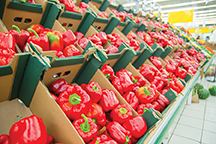Wholesale Market Scene
Despite its vast size, Texas has only a handful of sizeable terminal markets to serve wholesalers and distributors. Instead, there are many farmers’ markets and hybrids where consumers can shop alongside wholesalers for fresh produce and value-added products.
Dallas Changes Wholesaling
Although the Big D or Dallas, part of the Dallas/Ft. Worth metroplex, is certainly full of big city atmosphere, it is not home to a traditional terminal market. Instead, those within the industry—produce distributors, brokers, repackers, exporters, and receivers—are not found in a concentrated area, but spread out along the outskirts of the city.
Though the businesses are somewhat fragmented and may lack the cohesion many in the industry might prefer, there are still perks. Among the benefits are much more available space for cold storage, ripening rooms, loading, and receiving. Having a business on one of many highways also grants businesses quick connections to interstates to get to delivery stops faster. Such savings can make a location outside a busy terminal market more economical than those housed in the heart of the city.


Dallas, or the ‘Big D,’ is not home to a traditional terminal market.
The Dallas Farmers Market, known less formally as ‘the Shed,’ still represents the pulse of the produce industry in the Dallas/Ft. Worth region.
Opened back in 1941, investors took over the space and its aging facility in 2013, turning the wholesale market into a food and other item shopping ‘destination’ with a community garden and park, and plans for luxury apartments and condos.
The Shed is open seven days a week and serves North Texas with an aim to promote community and locally grown produce. In the summer of 2015, the Dallas produce hub initiated an interesting shift, one the market itself termed as ‘radical’—spotlighting local produce five days a week, and allowing the sale of nonlocal produce from dealers the other two days. With the help of the nonprofit organization GROW North Texas, the market has shifted to a true farmers’ market, championing locally grown foods.
McAllen Hustles and Bustles
The McAllen Produce Terminal Market, also known as the Central de Abastos, is a busy hub with as many as 200 trucks a day coming in and out. These carriers support 90 businesses on the premises who specialize in the rising number of perishable imports and exports crossing the border between the United States and Mexico.
The market facility, sprawled across 42 acres, is composed of five buildings with 294,000 square feet of space for its tenants and patrons. There is also ample activity surrounding the site, with new cold storage and warehouse facilities being built throughout the area.
The McAllen market’s website proclaims the terminal is an “irreplaceable link in the international produce scene” and continues to prove the mantra many times over as a significant port of entry for the Southeast and major pipeline for fresh fruit and vegetable receivers in the Midwest and along the East Coast. It doesn’t hurt that the terminal market’s host city, McAllen, is the Lone Star State’s fastest growing city and ranks eighth in the nation for the same honor as well.
San Antonio’s Prime Market
The San Antonio Wholesale Produce Market, referred to as SAWPM, is a newcomer—officially opening just last April. Years of planning went into the new facility, which specializes in innovative solutions for those in fresh produce along with the latest technology for cold storage and expedited movement.
The market’s campus offers another unique element: growers have the ability to work directly with buyers, which in many cases will be a first. And, the project has filled a much needed gap in local produce, giving room to 60 tenants in the first phase. Plans for phase two on the 212,400 square-foot facility are already moving forward, and continued expansion is planned well into the future.


San Antonio plays a consequential role in the perishables trade.
Abasto Corporation, the company behind the large project, believes this market will not only serve the huge San Antonio metro market, but pull traffic from McAllen as well—though this remains to be seen, since the markets are over 235 miles and three hours away from each other. Regardless, the SAWPM is situated in a prime location with easy access to Austin, Dallas, and Houston, as well as major arteries for both rail and highway systems to seamlessly link Texas shippers with receivers throughout the United States.
The market has helped put San Antonio on the map with a consequential role in the perishables trade with Mexico, especially with the latter’s infrastructure development for better produce flow to the United States.
Like McAllen, however, much depends on the U.S. trade relationship with Mexico and the Trump Admin-istration’s plans for a wall, immigration, and renegotiating NAFTA.
Retail Scene Trends
The Texas retail scene has seen shifts due to growing population and changing demographics. Those in the forefront are large, familiar chains such as H-E-B, Kroger, Walmart, and Whole Foods, along with plenty of smaller regional, ethnic, and independent stores.
Then there’s newcomer Aldi, making a splash in Texas and across the United States. “Aldi is playing the game a little different,” observes Ibarra, “by leading in a low cost/low overhead kind of experience.”


The retail scene is shifting due to population and demographic changes.
The niche Aldi has begun carving has caused some players to follow the German chain’s lead to simplify product lines and lower prices. Yet Ibarra believes the size and diversity of the state’s six prime urban regions—Dallas/Ft. Worth, Houston, San Antonio, El Paso, Austin, and the Rio Grande Valley—have enough demographically unique consumers to support a broad range of super- markets, from high-end specialty shops to budget-conscious disruptors.
Focus: Hispanic
With a significant population of Hispanics in Texas and growing spending power, the state’s supermarket industry is answering the call. Product mixes and services are differentiated, including an emphasis on shopping experience. From pickled cactus to piñatas, chains and independents offer a kaleidoscope of products that appeal to both U.S.-born and Hispanic immigrants.
El Rancho Supermercado’s mission is to provide an ‘at home’ atmosphere for customers and employees, creating a look that feels just like Mexico. Terry’s El Mariachi Supermarkets, known for their festive mariachi logo, is another leading independent grocery chain in North Texas, opening a store a year for the past 14 years.
Other key independent players include La Michoacana Meat Market, labeled the fastest-growing chain in the state. La Michoacana also happens to be the largest independent Hispanic grocery chain in the United States.
Others vying for shoppers include Los Altos Ranch Market, which has stores in Texas and throughout the Southwest; Mi Tienda with a dedicated customer base in Houston; and the more produce-forward Canino Produce Company, also known as Houston’s Farmers Market, which occupies a 20,000-square-foot space stocked with fresh produce.
FRESH FORUM
What do you consider the most critical issue facing the Texas produce industry?Scott Blanchard, Tomato Management Corporation
From a Latin American standpoint, trace-ability must continue to get better and better. From an American standpoint, it’s the Tomato Suspension Agreement; it’s the only item regulated as far as pricing structure.Steve Bramel, Bramel Trucking Company, Inc.
It would probably be: do we have a proper amount of labor for Texas produce to thrive? Problems with water have eased a bit with some of the weather we’ve had, there’s a little more available today than in the past. But it’s really water, labor, weather, and regulation: the age-old question of trying to produce with what’s given.Steve Cargil, Cargil Farms Produce
In our area, 80 miles west of San Antonio, water continues to be an issue. There’s also the cost for food safety and trying to recoup it from customers (not happening). Petroleum has come down, but not fertilizer or other items that create high production costs.Steve Ford, Dallas Direct Distributing, LLC
Weather is different now than it was 20 years ago: we get freezes, droughts, and substantial rain; floods are an issue. Another issue we all face are rules and regulations that change every year. Food safety is changing quickly and we need to stay on top of it.Juan Ibarra, Marengo Foods, LLC
On the foodservice side, there are three major players of which two were going to merge not too long ago and have not completely let go of the idea… On the side of wholesalers, I see the concept of terminal markets as a dead one, in this state. Companies have been driving away from this for some time now, working to become full-service providers.Jared Leadbetter, Majestic Produce Sales Company
We do have to evolve with the times and figure out other ways to make money…finding the balance of what people want and standing in the current. What we’re doing with standard packaging seems to be working, but we’re prepared to make any changes we can.
Rising Competition
Texans say everything is bigger in Texas, and this is true for grocery competition. Fiesta Mart, a pivotal player in the Houston area and for years the top store catering to Hispanic shoppers, has felt the crunch from national chains like Walmart and Kroger, as well as the Lone Star State’s own heavyweight H-E-B, and western up-and-comer WinCo, headquartered in Boise, ID, which has stores from Texas to Washington and nearly every state in between.
WinCo is concentrating some of its considerable might on the Texas market, with a new state-of-the-art distribution center in Denton, part of the sprawling Dallas/Ft. Worth metroplex. The facility, at 800,000 square feet, is the largest economic development project for Denton, and the center will service not only WinCo’s nine area stores, but those in nearby Oklahoma as well.
Like Aldi and Walmart, WinCo promises low prices, which appeal to all shoppers, including Hispanics who tend to cook at home more than other population segments. Along with national chains, independents, and regional favorites like itself, WinCo knows winning over the Hispanic demographic is crucial to success.
Offering the flavors, brands, and mainstay products these shoppers grew up with is half the battle. In Dallas/Fort Worth alone, the Hispanic population has risen to 2.2 million, with an average monthly grocery bill of $582 per household—an economic opportunity that more and more stores are catering to.
Cargil is excited about new meal delivery options, such as Blue Apron and Plated, which ship recipes and fresh ingredients—including plenty of fruits and vegetables—directly to consumers. He hopes the trend’s popularity will augment retail sales. “I’m interested to see if they spur a greater movement of eating fresh and healthy food,” he posits. “Anything we can do to get consumption up, I see it as a positive push for us.”
Packaging and Pricing
Recent packaging innovations range from increased demand for eco-friendly features, containers, and pouches with resealable flaps or tops, and a variety of sizing options to help reduce waste.
Stachurski says Hardie’s is “starting to see more demand for sustainable packaging in retail products.” To support these measures and more, he says all of the company’s facilities have been certified as ‘green’ or environmentally-responsible, and have both recycling and waste management capabilities.
Like many others along the produce supply chain, Stachurski sees sustainability as a leading trend in the industry. He is pleased to see some of the larger growers adapting more earth-friendly packaging, and most in the industry would welcome this kind of packaging as the norm rather than the exception.
Price vs. Planet
The role of cost, of course, must be acknowledged when such an endeavor is discussed. “What we’d like to do and what’s cost prohibitive are two different things,” Stachurski emphasizes. Never-theless, he relates, Hardie’s continues to make strides in “finding packaging that’s sustainable and affordable, so we can be good stewards and conscious of price.”
For Marengo Foods, most of the grower-shipper’s products are shipped bulk. But the supplier’s recent foray into bagged bell peppers, mini cucumbers, and mini peppers was a hit with retailers and consumers, opening the door to more packaging options.
Another supplier, Dallas Direct Distributing, LLC, is diving into ‘prepackaging,’ so retailers can use the product however they wish in displays or on shelves. “Everyone likes quick and easy,” comments managing member Steve Ford. But despite the popularity of newfangled packaging, he still believes in the importance of ‘old standbys’ like bulk for staple items with steady demand.


Bulk and specialized packaging are better designed to reduce waste.
Old & New
Others in the industry also designate themselves as “old school,” sticking to simple, but historically successful packaging for perennial favorites such as potatoes, onions, and carrots.
Because Majestic handles extra-large carrots and cabbage, rather than the specialized commodities that have been shifting to tricolored bags, Leadbetter sees an ongoing “demand for the standard 50-pound sack.”
Leadbetter believes the big bags have staying power because they work for their intended customers—such as foodservice for institutions, restaurants, and schools. At the end of the day, though, price—above all else—is often the primary factor in decision making. Fancy is nice, sustainable is great, but ‘standard’ pumps up the bottom line. “Price drives everything, and if the quality is there, people still want it because it’s cheaper.”
Bramel has noticed the emergence of condensed “consumer packs” for smaller grocery stores or restaurants, often halving the quantity. “When I started, there was a certain size box and that’s what you were going to get, even if you didn’t need it,” he explains. Today, however, with heightened concerns for waste, tailoring packaging options makes sense economically and environmentally.
Although not new, Cargil cites continuing demand for value-added convenience. Customers want products that are “ready to use in the restaurant or kitchen,” helping those who cook at home or in foodservice to reduce labor and prep time.
Images: Joel Pacheco, Valleyite12, David Litman, Laura Gunn, Sean Pavone, f11photo, Philip Lange, photo.ua,
Sean Pavone, David Litman/Shuterstock.com



